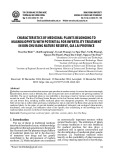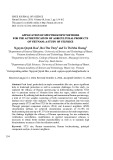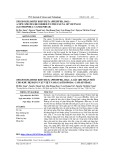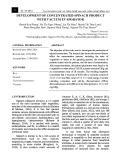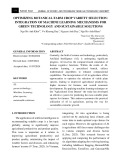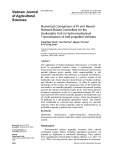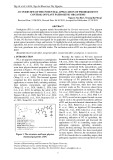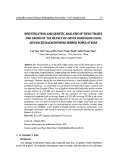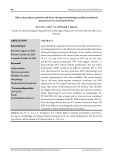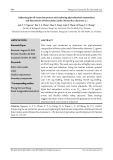
Int.J.Curr.Microbiol.App.Sci (2020) 9(4): 2034-2044
2034
Original Research Article https://doi.org/10.20546/ijcmas.2020.904.243
Effect of Dietary Nano Zinc Oxide Supplementation on Haematological
Parameters, Serum Biochemical Parameters and Hepato-Renal
Bio-Markers in Crossbred Calves
T. S. V. Anil1*, Ch. Venkata Seshaiah2, P. Ashalatha3 and K. Sudhakar4
1Rajamahendravaram Division, East Godavari District, Andhra Pradesh, India
2Livestock Farm Complex, NTR College of Veterinary Science, Sri Venkateswara Veterinary
University, Gannavaram, Andhra Pradesh, India
3Department of Livestock Production Management, NTR College of Veterinary Science,
Sri Venkateswara Veterinary University, Gannavaram, Andhra Pradesh, India
4Department of Animal Genetics and Breeding, NTR College of Veterinary Science,
Sri Venkateswara Veterinary University, Gannavaram, Andhra Pradesh, India
*Corresponding author
A B S T R A C T
Introduction
Proper mineral nutrition is the key to
successful dairying. Mineral deficiencies lead
to disease resulting in economic loss to the
farmer and Zinc is no exception. Zinc is a
trace mineral which caters many of the
operating metabolic functions in the body,
aids in animal growth, health, reproduction
and production. It conjugates with DNA-
International Journal of Current Microbiology and Applied Sciences
ISSN: 2319-7706 Volume 9 Number 4 (2020)
Journal homepage: http://www.ijcmas.com
To investigate the changes in the haematological, serum biochemical parameters and
hepato-renal biomarkers upon dietary supplementation of nano zinc oxide (nZnO) and its
effect on growth performance in calves, 24 weaned (6 months age) crossbred calves were
randomly distributed to four dietary plans (Control, Treatment1, Treatment2 and
Treatment3). The Control(C) group was fed exclusively with basal diet; T1 was
supplemented with 25ppm ZnSo4, T2 and T3 with 5ppm and 10ppm nZnO respectively,
along with the basal diet. Zinc content in basal was 26.24ppm. The haematological
parameters and few parameters viz., serum calcium, SGOT, blood urea nitrogen and
creatinine varied within the normal range upon nZnO supplementation. However, the
serum zinc, total protein, serum albumin and serum globulin were significantly (P<0.01)
higher in nZnO supplemented groups. There was a significant (P<0.05) difference in the
blood glucose levels between C and T2 on 45th day. And, the serum phosphorus level was
significantly (P<0.05) higher in T2 compared to T1 and T3. To conclude, nZnO has
significant effect on few serum biochemical parameters which supported the growth
performance of calves positively with a significant (P<0.01) improvement in the body
weight gain and average daily gain in nZnO supplemented groups.
K e y w o r d s
Crossbred calves,
Biochemical,
Haematological
parameters,
Supplementation
Accepted:
15 March 2020
Available Online:
10 April 2020
Article Info

Int.J.Curr.Microbiol.App.Sci (2020) 9(4): 2034-2044
2035
binding protein to regulate gene expression
participating in the nucleic acid (Hambidge et
al., 1986) and protein synthesis (Hidiroglou,
1980) to affect the growth rate of animals
(Chesters 1997 and MacDonald 2000). It is a
nutrient involved in functioning of a variety
of enzymes related to glucose, protein and
lipid metabolism, in hormone production and
secretion. Zinc also influences immune
system function (Shinde et al., 2006).
Many of the signalling pathways are zinc
dependent (Beattie and Kwun, 2004; Cousins
et al., 2006). The normal serum Zn
concentration is generally between 0.7 and
1.3 g/ml and the dietary requirements of Zn
for calves is about 33mg/kg (NRC, 2001). Zn
is reported to be deficient in several parts of
India (Alloway, 2004) in general and Andhra
Pradesh in particular (Nagalakshmi et al.,
2009) which reflectes in the Zn deficiency in
fodder. Adding to this, the soy bean meal
(contains phytates) which is a common
component of concentrate mixture and
unintended excess levels of Calcium in
general and few other elements like Fe and
Cu in the diet of animals depress the zinc
absorption and bioavailability. To avoid Zn
deficiency, the common practice is to add
conventional Zn supplements, over and above
the recommended level.
But, the conventional zinc is poorly soluble
and has lower bioavailability and requires
regular supplementation to maintain optimal
Zn levels in blood. Zinc lack storage reserves
in the body and high doses of zinc causes
toxicity with degenerative changes in liver,
kidney and pancreas (Allen et al., 1983). In
the present study nano zinc has been used
which has the advantage of higher
bioavailability at a lower rate of inclusion
(Patil et al., 2009). The haemopoetic system
actively responds to the exogenous substances
and to the changes of concentration and
exposure duration of exogenous substances
(Dimitrova et al., 2010). Few studies have
reported that higher Zn intake is associated
with severe cytopenia (Irving et al., 2003).
While some reported that, the dietary Zn
supplementation has no influence on few or
all the haematological parameters in different
species of livestock and poultry (Ramulu et
al., 2015; Elamin et al., 2013; Milani et al.,
2017). However, very scanty information is
available on haemoto-biochemical parameters
upon supplementation of nZnO especially in
crossbred calves. So this work was taken up
to investigate the changes in haematological
and biochemical parameters upon nZnO
supplementation in crossbred calves.
Materials and Methods
24 crossbred calves of 6 months age which
were randomly distributed in four groups
(Control, Treatment1, Treatment2 and
Treatment3) of six calves in a completely
randomized block design. Calves were kept in
well ventilated house with concrete flooring
having provision of individual feeding and
watering and also provided a 15-day
adaptation period where the calves were fed
with basal diet. The concentrate mixture was
prepared with all the minerals except Zinc.
The zinc content in the basal diet was found
to be 26.24ppm which was tested using
inductively coupled plasma atomic emission
spectroscopy (ICP-OES).
Deworming and deticking was done before
the start of the experiment. The calves were
assigned to different dietary treatments viz.,
Control(C) group where calves were fed with
basal diet only, T1, T2 and T3 were
supplemented with 25ppm ZnSo4 , 5ppm and
10ppm of nZnO respectively, along with the
basal diet. Two blood samples were collected
aseptically at fortnight intervals via a single
jugular venepuncture from each calf, one
sample was collected into EDTA vaccutainer
for haematological analysis and the other

Int.J.Curr.Microbiol.App.Sci (2020) 9(4): 2034-2044
2036
sample into an anti-coagulant free centrifuge
tube to obtain serum. The whole blood
collected into EDTA vaccutainer was kept for
analysis of haematological constituents (Hb,
RBC, WBC, Platelets and MCV) using
automatic haematology analyser. Serum
samples were obtained after centrifuging
whole blood at 2000 x g for 10 min; 4º C in
refrigerated centrifuge and serum was
collected into eppendorf tubes and stored.
Serum stored in eppendorf tubes was analysed
for serum biochemical parameters and few
basic hepato-renal biomarkers (Serum Ca, P,
Zn, Albumin, Globulin, Total Protein,
Glucose, SGOT, BUN and Creatinine) using
commercially available kits of Erba
Mannheim and Genx Proton Bologicals (zinc
kit). The concentrations of the parameters in
serum and data analysis of results were
performed using spectrophotometer and
ANOVA, Post-hoc tests in SPSS version
(15.01) (SPSS, 2006) respectively.
Results and Discussion
Haematological parameters
The results on the effect of dietary
supplementation of nZnO on Hb
concentration, RBC, WBC, Platelet count and
MCV in crossbred calves are represented in
the Table 1. The result revealed that there was
no statistically significant difference with
regard to all the haematological parameters
among the groups as the parameters varied
within the physiological normal range.
The results are in agreement with the findings
of Ramulu et al., (2015) in buffalo calves and
Milani et al., (2017) in weanling pigs
observed no significant difference in all the
haematological parameters upon
supplementation of conventional zinc and
nZnO respectively. Similarly, Elamin et al.,
(2013) found no effect of supplemental zinc
on Hb concentration, RBC and WBC count in
goat Kids. Also, Ismail and El-Araby (2017)
in rabbits found no observable variation in the
Hb concentration and RBC count. In contrary,
Sobhanirad et al., (2014) reported a
statistically significant difference in all the
haematological parameters of lambs among
the groups upon supplementation of Zn. Also,
Ismail and El-Araby (2017) found a highly
significant increase in total leukocytic count
in ZnO NPs supplemented rabbits groups.
Zn at higher concentrations tends to inhibit
copper and iron absorption (Salama et al.,
2003) which are required for RBC and WBC
proliferation and maturation. Here in the
present study, the haematological parameters
were in normal range which could be due to
the level of inclusion of Zn of the study which
might not have interfered with the Cu and Fe
so as to affect the haemogram.
Serum glucose level
The results of effect of dietary
supplementation of nZnO on serum glucose
level of crossbred calves are represented in
the Table 2. The statistical analysis revealed
that there was no significant difference in
serum glucose level among the groups except
on 45th day (P<0.05) where the mean serum
glucose level was higher in control group
compared to groups supplemented with ZnO.
Similar to the results of our study, the serum
glucose levels in poultry birds did not differ
significantly between control and zinc
supplemented groups (Sahoo et al., 2014;
Fathi., 2016 and Idowu et al., 2011). In
contrary, Sethy et al., (2016) and Elamin et
al., (2013) reported that the serum glucose
concentration in goats increased significantly
(P<0.05) between the groups supplemented
with inorganic and organic zinc in diet.
Similar findings were made by Mishra et al.,
(2014) in chicks supplemented with nano
zinc.

Int.J.Curr.Microbiol.App.Sci (2020) 9(4): 2034-2044
2037
Serum mineral parameters
The results of effect of dietary
supplementation of nZnO on different serum
minerals are presented in the Table 3
suggesting that the calcium remained
unchanged, phosphorus was significantly
(P<0.05) higher in nano zinc supplemented
group on 30th day of experiment and serum
zinc level was significantly higher (P<0.01) in
the groups supplemented with nano zinc
oxide @ 10ppm.
The results of our study are in accordance
with the findings of Zaboli et al., (2013) in
Markhoz goat kids and Sahoo et al., (2014) in
broiler chicks who did not observe any
significant difference in serum concentration
of Ca and P among the groups upon
supplementation of nano zinc. Similarly,
Sahoo et al., (2014) and Raya et al., (2016)
found that nanoparticles increased serum zinc
concentration significantly in broilers and rats
respectively. Garg et al., (2008) also reported
that the supplementation of zinc had no effect
on serum inorganic P levels. Further, Dresler
et al., (2016) in cattle calves and Ramulu et
al., (2015) in buffalo calves observed a
significant increase in serum zinc
concentration when nano zinc is
supplemented and Li et al., (2016) in
weanling pigs observed a significant increase
in serum zinc concentration when nano zinc is
supplemented.
In contrary, Al-Daraji and Amen (2011)
reported a significantly (P<0.05) higher level
of serum calcium and phosphorus on
increasing zinc levels in the diets of broilers.
But, Daghash and Mousa (1999) and Thilsing
and Jorgensen (2001) noticed a significant
drop in serum calcium level in buffaloes and
cows respectively when supplemented with
conventional zinc in their diets. Abedini et al.,
(2017) reported that plasma zinc
concentration was not significantly affected
by the supplementation of layer diet with
different sources of zinc. Similarly, Zaboli et
al., (2013) and Najafzadeh et al., (2013) also
reported that there were no significant
differences in serum concentrations of Zn
between the groups supplemented with
different forms to zinc in goat kids and lambs
respectively. However, Phiri et al., (2009)
reported that supplementation of zinc oxide to
goats decreased the phosphorus concentration
in the blood.
Many studies indicated that there exists an
antagonistic effect between zinc and calcium.
However, in the present study the dietary
supplemental zinc might have been not so
high as to affect the levels of calcium in the
serum. From the results of the present study,
it is very clear that, the level of inclusion of
zinc in the study has no prominent effect on
serum phosphorus levels in crossbred calves.
The raise in serum zinc levels of the groups
supplemented with nZnO in the present study
was obvious and is attributed to the higher
bioavailability of nZnO when compared to the
conventional zinc source (Sahoo et al., 2014).
Serum protein parameters
Serum albumin
The results on the effect of dietary
supplementation of nZnO on serum protein
components level in crossbred calves are
represented in the Table 4. Statistical analysis
revealed that the mean albumin concentration
in serum of all calves varied within the
normal range with serum albumin being
significantly (P<0.01) lower in T1 compared
to C, T2 andT3 on 15th, 30th, 75th days of
experiment. Similar results were documented
by Ramulu et al., (2015) and Sahoo et al.,
(2014) who observed that the serum albumin
was comparable among experimental groups
supplemented with different sources of zinc in
calves and broiler chicks respectively.

Int.J.Curr.Microbiol.App.Sci (2020) 9(4): 2034-2044
2038
In contrary, a significant increase in serum
albumin concentration in crossbred was
reported in calves fed a diet containing
different sources of Zinc by Mandal (2004)
and Dresler et al., (2016). Similar findings
were reported by Nobijari et al., (2012) in
young Holstein bulls. In contrary, the results
of Ismail and El-Araby (2017) showed that
there is a highly significant decrease in
albumin levels in ZnO NPs group of rabbits.
Serum globulin
The results on the effect of dietary
supplementation of nZnO on serum protein
components level in crossbred calves are
represented in the Table 4. Statistical analysis
revealed that the serum globulin levels were
significantly (P < 0.01) higher in group
supplemented with nZnO @ 10 ppm
compared to other groups.
The increased globulin concentrations in
serum of crossbred calves supplemented with
nZnO might be attributed to the functional
role of zinc in protein synthesis and this
improved globulin level implies to better
immune response as serum globulins playing
a role in immune response (immunoglobulins
or antibodies) and provide an early line of
defence.
In accordance to the present study, the reports
of Ramulu et al., (2015) in buffalo calves and
(Gaafar et al., 2011) in lactating Friesian
cows witnessed a significant increase in
serum globulin concentration among the
experimental groups supplemented with zinc.
In contrary with our results, Ismail and El-
Araby (2017) showed that there is a highly
significant decrease in globulin levels of
Rabbits fed with ZnO NPs. On the other hand,
Sahoo et al., (2014) observed no significant
variation in serum globulin levels ofbroiler
chicks treated with different sources of zinc.
Total protein
The results on the effect of dietary
supplementation of nZnO on serum protein
components level in crossbred calves are
represented in the Table 4. Statistical analysis
revealed that there was a significantly
(P<0.01) higher total protein levels in the
serum of groups supplemented with nZnO @
10ppm compared to the other groups and
control. The improved total protein
concentration in serum of crossbred calves
supplemented with nZnO might be attributed
to the functional role of zinc in protein
synthesis as suggested by Ibs and Rink
(2003).
The results of the present study are in
agreement with the reports of Nobijari et al.,
(2012) in young Holstein bulls and Dresler et
al., (2016) in calves wherein the zinc
supplementation increased the total protein
levels significantly (P < 0.05). In contrary,
Ismail and El-Araby (2017) observed that
there is a highly significant decrease in serum
total protein levels in rabbits supplemented
with ZnO NPs in the diet. On the other hand,
the findings of Sahoo et al., (2014) and Fathi
(2016) in broiler chicks and Ramulu et al.,
(2015) in buffalo calves revealed that there
was no significant variation in serum total
protein levels among the groups treated with
different sources of zinc.
Albumin to globulin (A/G) ratio
The results on the effect of dietary
supplementation of nZnO on serum protein
components level in crossbred calves are
represented in the Table 4. Statistical analysis
revealed that the A/G ratio varied within the
normal range in all the groups with A/G being
significantly (P<0.01) low in the nZnO
supplemented groups. Similarly, Mishra et al.,
(2014) found relatively lower A/G ratio in the
groups supplemented with nZnO when

